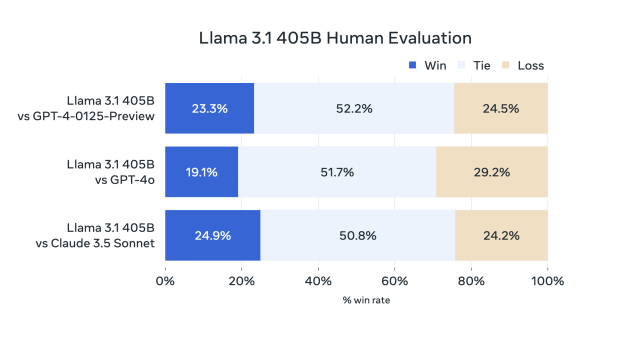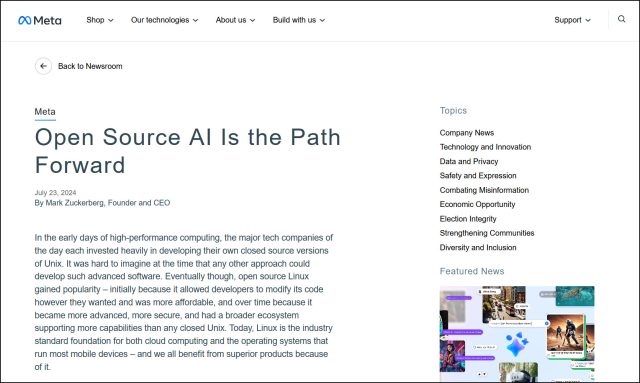Meta axes third-party fact-checkers in time for second Trump term
Zuckerberg says Meta will “work with President Trump” to fight censorship.
Meta CEO Mark Zuckerberg during the Meta Connect event in Menlo Park, California on September 25, 2024. Credit: Getty Images | Bloomberg
Meta announced today that it’s ending the third-party fact-checking program it introduced in 2016, and will rely instead on a Community Notes approach similar to what’s used on Elon Musk’s X platform.
The end of third-party fact-checking and related changes to Meta policies could help the company make friends in the Trump administration and in governments of conservative-leaning states that have tried to impose legal limits on content moderation. The operator of Facebook and Instagram announced the changes in a blog post and a video message recorded by CEO Mark Zuckerberg.
“Governments and legacy media have pushed to censor more and more. A lot of this is clearly political,” Zuckerberg said. He said the recent elections “feel like a cultural tipping point toward once again prioritizing speech.”
“We’re going to get rid of fact-checkers and replace them with Community Notes, similar to X, starting in the US,” Zuckerberg said. “After Trump first got elected in 2016, the legacy media wrote nonstop about how misinformation was a threat to democracy. We tried in good faith to address those concerns without becoming the arbiters of truth. But the fact-checkers have just been too politically biased and have destroyed more trust than they’ve created, especially in the US.”
Meta says the soon-to-be-discontinued fact-checking program includes over 90 third-party organizations that evaluate posts in over 60 languages. The US-based fact-checkers are AFP USA, Check Your Fact, Factcheck.org, Lead Stories, PolitiFact, Science Feedback, Reuters Fact Check, TelevisaUnivision, The Dispatch, and USA Today.
The independent fact-checkers rate the accuracy of posts and apply ratings such as False, Altered, Partly False, Missing Context, Satire, and True. Meta adds notices to posts rated as false or misleading and notifies users before they try to share the content or if they shared it in the past.
Meta: Experts “have their own biases”
In the blog post that accompanied Zuckerberg’s video message, Chief Global Affairs Officer Joel Kaplan said the 2016 decision to use independent fact-checkers seemed like “the best and most reasonable choice at the time… The intention of the program was to have these independent experts give people more information about the things they see online, particularly viral hoaxes, so they were able to judge for themselves what they saw and read.”
But experts “have their own biases and perspectives,” and the program imposed “intrusive labels and reduced distribution” of content “that people would understand to be legitimate political speech and debate,” Kaplan wrote.
The X-style Community Notes system lets the community “decide when posts are potentially misleading and need more context, and people across a diverse range of perspectives decide what sort of context is helpful for other users to see… Just like they do on X, Community Notes [on Meta sites] will require agreement between people with a range of perspectives to help prevent biased ratings,” Kaplan wrote.
The end of third-party fact-checking will be implemented in the US before other countries. Meta will also move its internal trust and safety and content moderation teams out of California, Zuckerberg said. “Our US-based content review is going to be based in Texas. As we work to promote free expression, I think it will help us build trust to do this work in places where there is less concern about the bias of our teams,” he said. Meta will continue to take “legitimately bad stuff” like drugs, terrorism, and child exploitation “very seriously,” Zuckerberg said.
Zuckerberg pledges to work with Trump
Meta will “phase in a more comprehensive community notes system” over the next couple of months, Zuckerberg said. Meta, which donated $1 million to Trump’s inaugural fund, will also “work with President Trump to push back on governments around the world that are going after American companies and pushing to censor more,” Zuckerberg said.
Zuckerberg said that “Europe has an ever-increasing number of laws institutionalizing censorship,” that “Latin American countries have secret courts that can quietly order companies to take things down,” and that “China has censored apps from even working in the country.” Meta needs “the support of the US government” to push back against other countries’ content-restriction orders, he said.
“That’s why it’s been so difficult over the past four years when even the US government has pushed for censorship,” Zuckerberg said, referring to the Biden administration. “By going after US and other American companies, it has emboldened other governments to go even further. But now we have the opportunity to restore free expression, and I am excited to take it.”
Brendan Carr, Trump’s pick to lead the Federal Communications Commission, praised Meta’s policy changes. Carr has promised to shift the FCC’s focus from regulating telecom companies to cracking down on Big Tech and media companies that he alleges are part of a “censorship cartel.”
“President Trump’s resolute and strong support for the free speech rights of everyday Americans is already paying dividends,” Carr wrote on X today. “Facebook’s announcements is [sic] a good step in the right direction. I look forward to monitoring these developments and their implementation. The work continues until the censorship cartel is completely dismantled and destroyed.”
Group: Meta is “saying the truth doesn’t matter”
Meta’s changes were criticized by Public Citizen, a nonprofit advocacy group founded by Ralph Nader. “Asking users to fact-check themselves is tantamount to Meta saying the truth doesn’t matter,” Public Citizen co-president Lisa Gilbert said. “Misinformation will flow more freely with this policy change, as we cannot assume that corrections will be made when false information proliferates. The American people deserve accurate information about our elections, health risks, the environment, and much more.”
Media advocacy group Free Press said that “Zuckerberg is one of many billionaires who are cozying up to dangerous demagogues like Trump and pushing initiatives that favor their bottom lines at the expense of everything and everyone else.” Meta appears to be abandoning its “responsibility to protect its many users, and align[ing] the company more closely with an incoming president who’s a known enemy of accountability,” Free Press Senior Counsel Nora Benavidez said.
X’s Community Notes system was criticized in a recent report by the Center for Countering Digital Hate (CCDH), which said it “found that 74 percent of accurate community notes on US election misinformation never get shown to users.” (X previously sued the CCDH, but the lawsuit was dismissed by a federal judge.)
Previewing other changes, Zuckerberg said that Meta will eliminate content restrictions “that are just out of touch with mainstream discourse” and change how it enforces policies “to reduce the mistakes that account for the vast majority of censorship on our platforms.”
“We used to have filters that scanned for any policy violation. Now, we’re going to focus those filters on tackling illegal and high-severity violations, and for lower severity violations, we’re going to rely on someone reporting an issue before we take action,” he said. “The problem is the filters make mistakes, and they take down a lot of content that they shouldn’t. So by dialing them back, we’re going to dramatically reduce the amount of censorship on our platforms.”
Meta to relax filters, recommend more political content
Zuckerberg said Meta will re-tune content filters “to require much higher confidence before taking down content.” He said this means Meta will “catch less bad stuff” but will “also reduce the number of innocent people’s posts and accounts that we accidentally take down.”
Meta has “built a lot of complex systems to moderate content,” he noted. Even if these systems “accidentally censor just 1 percent of posts, that’s millions of people, and we’ve reached a point where it’s just too many mistakes and too much censorship,” he said.
Kaplan wrote that Meta has censored too much harmless content and that “too many people find themselves wrongly locked up in ‘Facebook jail.'”
“In recent years we’ve developed increasingly complex systems to manage content across our platforms, partly in response to societal and political pressure to moderate content,” Kaplan wrote. “This approach has gone too far. As well-intentioned as many of these efforts have been, they have expanded over time to the point where we are making too many mistakes, frustrating our users and too often getting in the way of the free expression we set out to enable.”
Another upcoming change is that Meta will recommend more political posts. “For a while, the community asked to see less politics because it was making people stressed, so we stopped recommending these posts,” Zuckerberg said. “But it feels like we’re in a new era now, and we’re starting to get feedback that people want to see this content again, so we’re going to start phasing this back into Facebook, Instagram, and Threads while working to keep the communities friendly and positive.”
Meta axes third-party fact-checkers in time for second Trump term Read More »






































